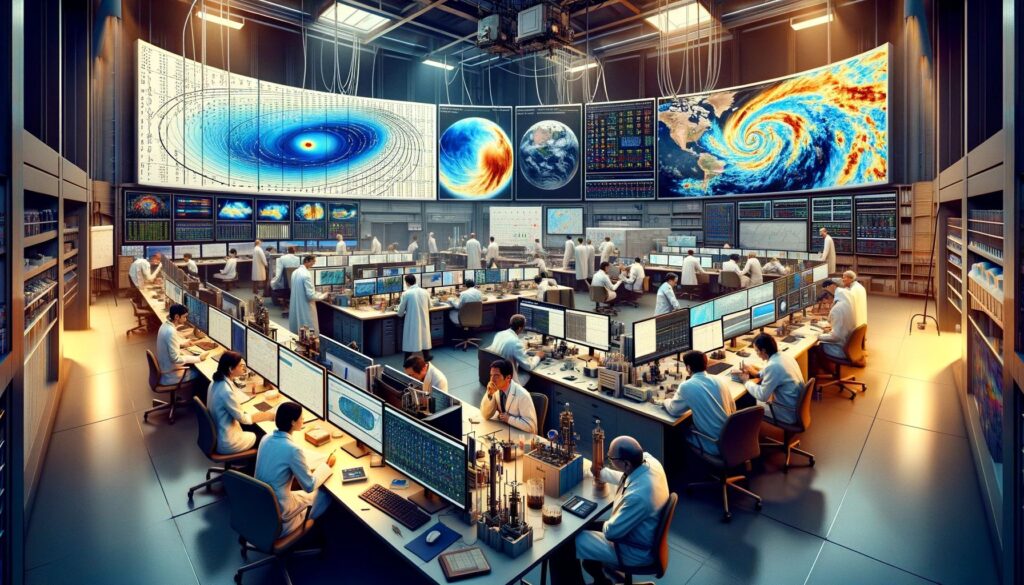The integration of Artificial Intelligence (AI) into meteorology is a transformative development, revolutionizing weather forecasting and climate modeling. By analyzing vast datasets and identifying complex patterns, AI enhances the accuracy and efficiency of predictions, reshaping our understanding and approach to atmospheric sciences.
The Evolution of Weather Forecasting and Climate Modeling
The quest to predict the weather and understand climate patterns has been a cornerstone of human inquiry for centuries. From early methods relying on observations of the sky and natural indicators to the sophisticated use of satellites and radar technology, meteorology has undergone a remarkable transformation. Today, at the forefront of this evolution is the integration of Artificial Intelligence (AI), a leap that is reshaping how we approach weather forecasting and climate modeling.
Integration of AI in Meteorology
Artificial Intelligence, in the context of meteorology, is more than just a technological tool; it’s a paradigm shift. The vast and complex nature of weather systems, combined with the intricate variables influencing climate change, make these fields ideal candidates for the application of AI. With its ability to process large datasets and identify patterns beyond human capabilities, AI is not just enhancing existing models but is also enabling meteorologists and scientists to explore new frontiers in understanding the Earth’s atmospheric phenomena.
AI’s Impact on Data Interpretation and Model Enhancement
AI’s role in meteorology significantly impacts data interpretation, where machine learning algorithms excel in analyzing vast, complex datasets encompassing variables like temperature, humidity, wind patterns, and solar radiation. These algorithms swiftly identify trends and make accurate predictions, surpassing traditional methods. AI also enhances climate modeling by analyzing extensive historical data, recognizing patterns, and considering numerous variables. This capability refines predictions about future climatic conditions, making AI indispensable in understanding and forecasting long-term climate patterns.
| Aspect | Traditional Methods | AI-Enhanced Methods |
| Data Processing Speed | Moderate | High |
| Accuracy of Predictions | Varies | Significantly Improved |
| Ability to Handle Big Data | Limited | Exceptional |
| Adaptability to New Data | Low | High |
| Cost Efficiency | Moderate | High (Long-Term) |
Understanding AI and Its Meteorological Applications
Basic Principles of Artificial Intelligence
Artificial Intelligence (AI) encompasses a range of technologies and methodologies designed to enable machines to mimic human cognitive functions such as learning, problem-solving, and pattern recognition. At its core, AI operates on the following principles:
- Machine Learning: AI systems learn from vast datasets, improving their performance and accuracy over time without being explicitly programmed for each task.
- Neural Networks: These are structured like the human brain, with layers of interconnected nodes (‘neurons’) that process and transmit information, enabling AI to make decisions and predictions.
- Natural Language Processing (NLP): This enables AI to understand and interact using human language, vital for translating and interpreting textual data.
- Computer Vision: AI’s ability to interpret and analyze visual information from the world, such as images and videos, plays a crucial role in analyzing satellite imagery and radar data in meteorology.
- Predictive Analytics: AI uses historical data to make predictions about future events, a key component in forecasting weather and climate patterns.
How AI is Being Applied in Meteorology
AI is revolutionizing meteorology by enhancing weather forecasting and climate modeling. Machine learning algorithms analyze vast data from weather stations, satellites, and sensors, identifying complex atmospheric patterns for accurate predictions. AI improves short-term forecasts, severe weather predictions, and refines climate models, offering precise future climate simulations. Integrating AI with meteorological tools like radar improves analyses, speeds up weather warnings, and boosts disaster response. This transformation deepens our understanding of atmospheric changes and augments our predictive capabilities.
Improvements in Weather Prediction Accuracy

Examples Demonstrating Improved Weather Forecasting Accuracy Through AI
Recent case studies highlight AI’s role in enhancing weather prediction accuracy. For instance, the National Center for Atmospheric Research used machine learning to improve severe weather event predictions, including thunderstorms and heavy rainfall, with notable precision. Similarly, collaborations between meteorological institutes and tech companies have leveraged AI for more accurate hurricane path predictions by analyzing extensive datasets like ocean temperature and atmospheric pressure. These advancements demonstrate AI’s significant potential in improving forecast precision, especially in predicting and mitigating severe weather events.
Comparing Traditional Methods vs AI-Enhanced Methods
AI in meteorology represents a shift from traditional methods with several advantages:
- Data Processing: AI rapidly processes vast datasets, detecting patterns efficiently.
- Prediction Accuracy: AI consistently excels in short-term and severe weather predictions.
- Scalability: AI handles larger datasets and complex simulations more effectively.
- Adaptive Learning: AI learns and adjusts continuously, eliminating the need for manual updates.
- Real-time Analysis: AI provides immediate insights, unlike traditional methods with longer processing times.
- Cost-Efficiency: While requiring initial investment, AI saves costs through improved efficiency and reduced manpower.
AI in Climate Modeling and Long-Term Predictions
The Role of AI in Understanding Climate Change
AI is pivotal in advancing climate change understanding by analyzing complex data, revealing hidden patterns. It processes vast, diverse data sources like satellite imagery and historical records, offering comprehensive insights. This approach is crucial for predicting climate scenarios and assessing environmental policies. AI enhances climate models, considering variables like emissions, deforestation, and urbanization, fostering accurate predictions.
Examples of AI Models Used in Long-Term Climate Predictions
Several AI models have been instrumental in enhancing long-term climate predictions:
- Deep Learning Models: Process vast data, ideal for long-term climate trend prediction.
- Generative Adversarial Networks (GANs): Create detailed climate simulations from historical data.
- Reinforcement Learning Algorithms: Optimize models for improved, adaptive long-term forecasting.
- Ensemble Models: Combine multiple AI predictions for enhanced reliability.
- Time Series Analysis Models: Vital for understanding and predicting trends over time, e.g., temperature rise or sea level changes.
Challenges and Limitations of AI in Meteorology

Discussing the Current Challenges Faced in AI Implementations
Despite the significant advancements brought by AI in meteorology, there are several challenges in its implementation:
- Data Quality and Availability: High-quality, comprehensive data is crucial for AI models. Inconsistent or incomplete data can lead to inaccuracies in predictions.
- Interpretability of AI Models: Understanding how AI models arrive at certain predictions (the “black box” problem) remains a challenge, impacting the trust and reliability of these models.
- Integration with Existing Systems: Incorporating AI into existing meteorological frameworks can be challenging, requiring significant changes in infrastructure and workflows.
- Cost and Resource Intensity: Developing and maintaining AI systems can be resource-intensive and costly, especially for resource-limited organizations and developing countries.
- Training and Expertise: There is a need for skilled professionals who understand both meteorology and AI, a combination that is currently rare.
- Ethical and Privacy Concerns: Use of AI in data collection and analysis raises concerns about privacy, especially with data that can be traced back to individuals or specific locations.
Limitations in Terms of Data, Computing Power, and Model Complexity
The effectiveness of AI in meteorology is also bounded by certain limitations:
- Data Limitations: AI relies on available data; scarcity and inconsistent formats worldwide hinder learning and predictions.
- Computing Power: Resource-constrained areas struggle with the computing demands of large AI models.
- Model Complexity: Complex AI models can be challenging to interpret and manage, leading to resistance from traditional meteorologists.
- Data Integration: Harmonizing data from diverse sources, periods, and locations poses significant challenges for effective AI processing.
The Prospects of AI in Weather and Climate Science
Emerging Technologies and Future Prospects
The future of AI in weather and climate science is bright, with technologies like quantum computing set to enhance data processing for more accurate, rapid predictions. The integration of IoT devices will enrich data collection globally. Advancements in deep learning and neural networks are expected to improve model accuracy and efficiency. The trend towards open-source AI models promises increased innovation and collaboration. These developments indicate a future where AI predicts weather and climate changes with unprecedented accuracy, speed, and efficiency, becoming an essential tool in meteorology.
Potential Impacts on Policy Making and Disaster Management
The integration of AI in weather and climate science holds significant implications for policy making and disaster management:
- Improved Decision-Making: Enhanced predictive capabilities will enable policymakers to make more informed decisions regarding climate change mitigation and adaptation strategies.
- Early Warning Systems: AI-driven early warning systems will provide more accurate and timely alerts for extreme weather events, reducing risk and potential damage.
- Resource Allocation: AI can assist in optimizing the allocation of resources in disaster management, ensuring efficient and effective responses.
- Urban Planning: Insights from AI-enhanced climate models can guide urban and infrastructure planning, promoting resilience against climate change and extreme weather.
- Agricultural Policies: AI’s predictions on weather patterns can inform agricultural policies, helping to mitigate the impacts of climate change on food security.
- Environmental Protection: AI can aid in monitoring and protecting ecosystems by predicting and mitigating the effects of climate change on biodiversity.
- Public Awareness and Education: The dissemination of AI-generated weather and climate information can increase public awareness and understanding of climate change, supporting more sustainable practices.
Conclusion: The Impact of AI on Meteorology
Artificial Intelligence has revolutionized meteorology and climate science, processing vast data for improved weather forecasting and a deeper understanding of climate patterns. This integration signifies a major advancement, providing more reliable predictions vital for disaster preparedness, resource management, and environmental protection. As AI continues to advance, its influence on decision-making, policy formulation, and public awareness will grow, enhancing our scientific capabilities and proactive efforts to safeguard our planet. The journey of AI in this field is just beginning, promising significant impacts in the future.




